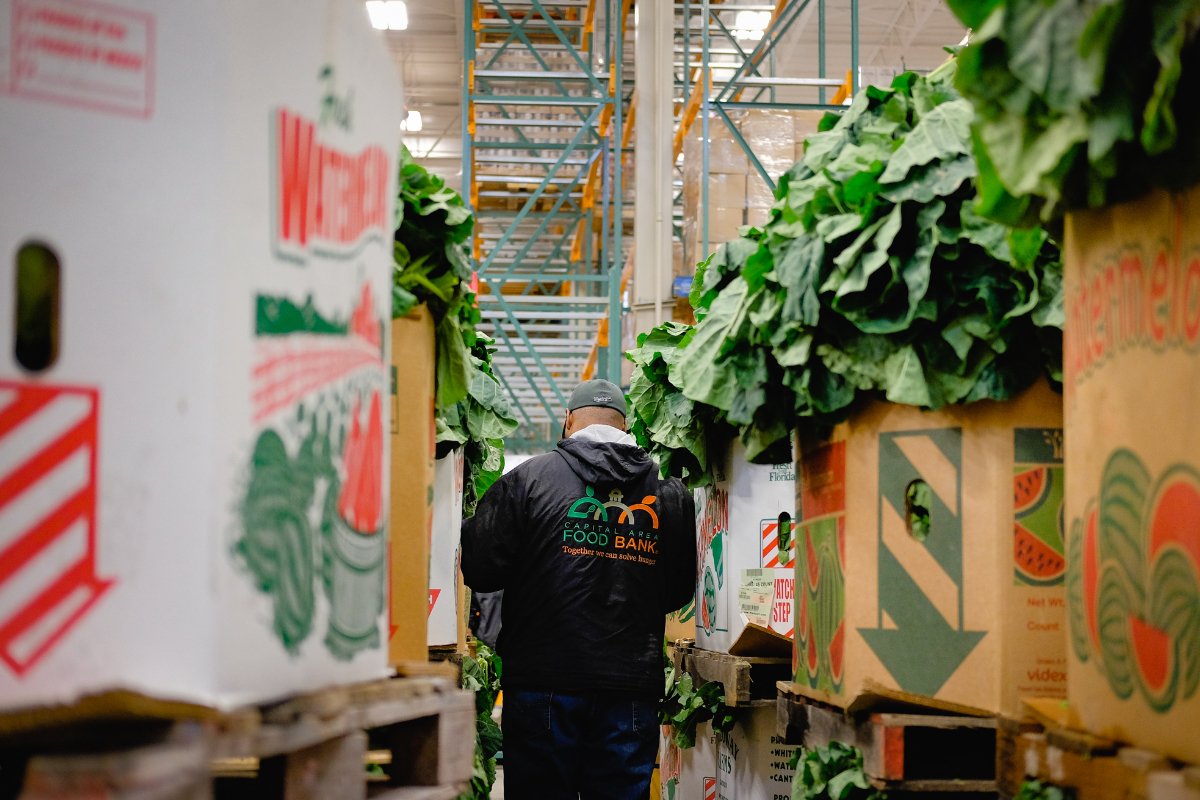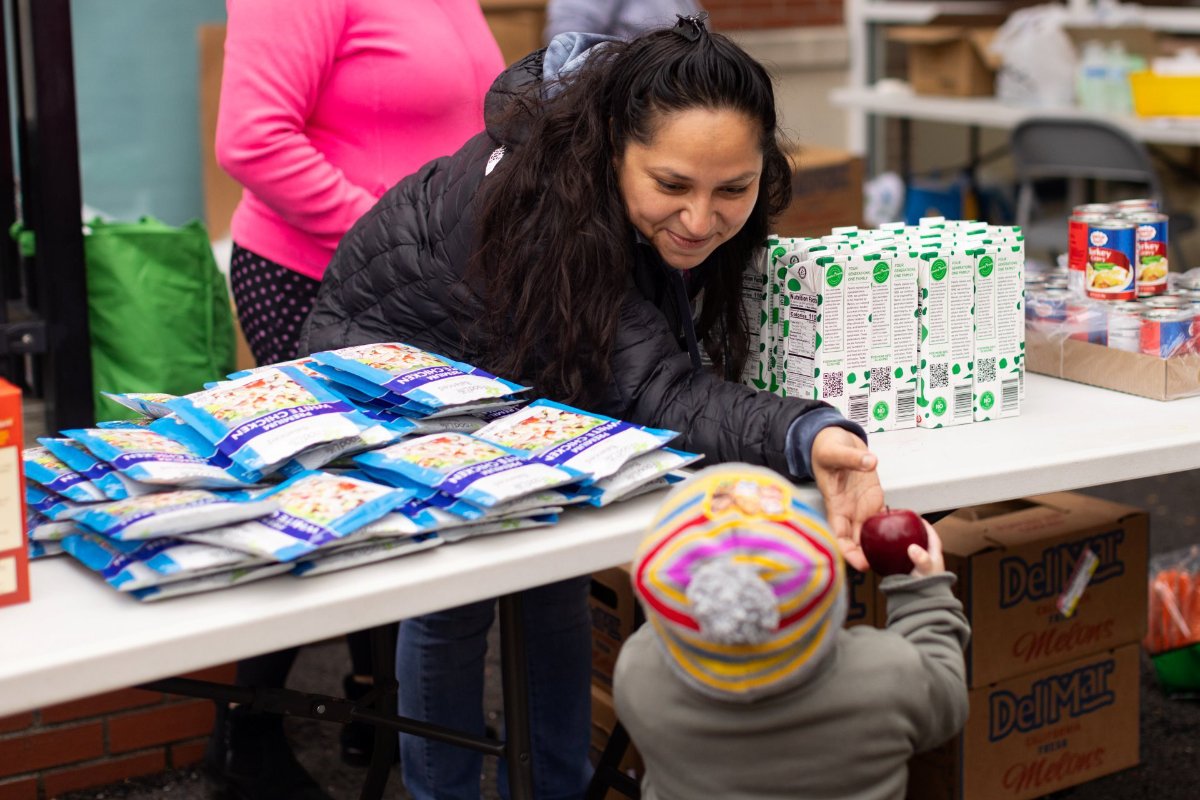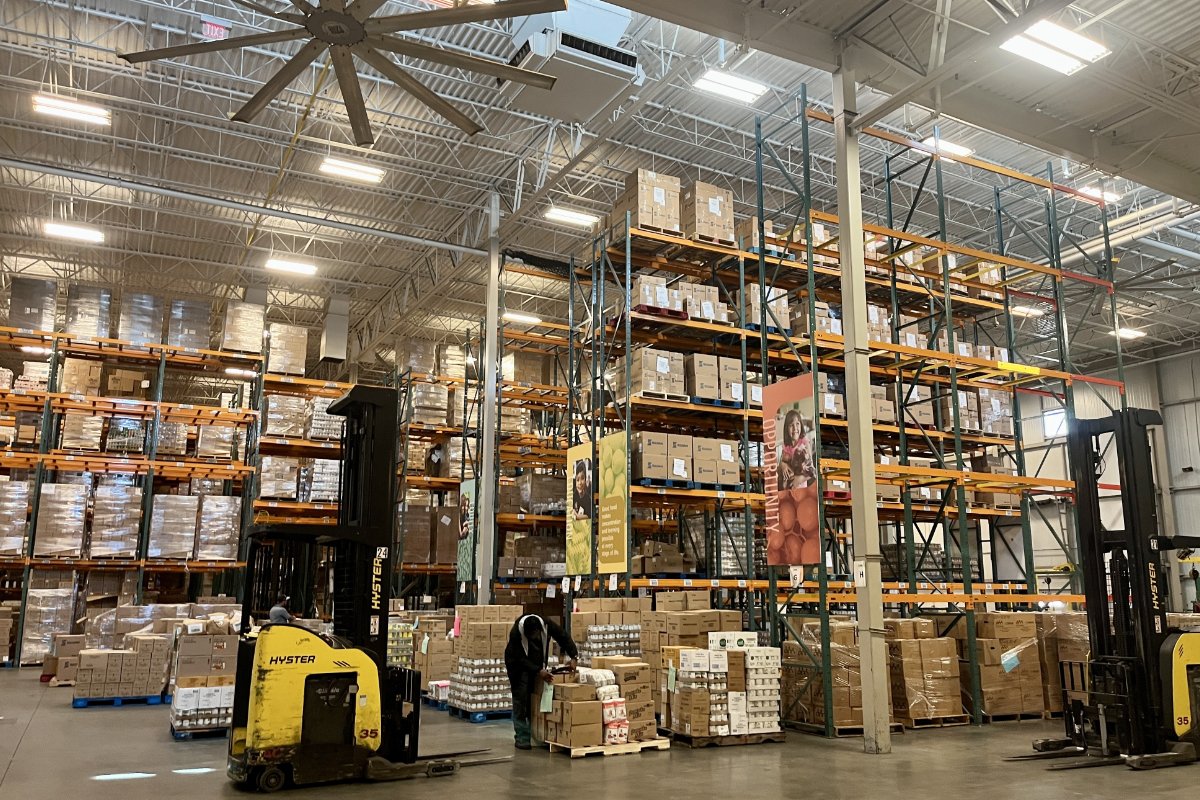In their ‘Big, Beautiful Bill,’ Republicans are proposing major changes to food assistance. Experts warn that will mean increased hunger for millions of people.

In their ‘Big, Beautiful Bill,’ Republicans are proposing major changes to food assistance. Experts warn that will mean increased hunger for millions of people.
July 1, 2025

A warehouse staffer moves through rows of produce at the Capital Area Food Bank in Washington, D.C. While some goods remain stocked, many shelves at the food bank are currently empty, due to recent funding cuts at the U.S. Department of Agriculture. (Photo: Capital Area Food Bank)
In Washington, D.C., a few miles north of Capitol Hill, where members of Congress are battling over federal food assistance, workers driving forklifts lean on their horns and whip around corners at the Capital Area Food Bank’s 100,000-square-foot warehouse.
Expand your understanding of food systems as a Civil Eats member. Enjoy unlimited access to our groundbreaking reporting, engage with experts, and connect with a community of changemakers.
Already a member?
Login
Near the loading dock, a shipment of kale awaits transport to refrigerated storage, the curly green leaves poking out of boxes from a nearby farm. More boxes of food, including brown rice, coconut milk, and Corn Flakes, are stacked on towering shelves.
Some shelves, however, are notably empty.
Due to funding cuts at the U.S. Department of Agriculture (USDA) over the last several months, the food bank lost more than 25 tractor-trailer loads of food between April and June and an expected $2 million that would have been used to purchase local produce next year. As other food banks across the country have reported, Capital Area’s President and CEO Radha Muthiah said that demand here is way up. Now, her team is preparing for another rush.
“We know that with any reduction in SNAP [the Supplemental Nutrition Assistance Program], people are going to look to try and make that [food] up in other ways, and certainly looking to us and our network will be one of those ways,” she said.
More than 40 million Americans rely on SNAP for food aid. But Republicans are counting on major changes to the program to help fund tax cuts in their “One Big, Beautiful Bill,” which they hope to have to President Donald Trump by July 4. In 2023, SNAP cost $113 billion.
Their plans would fundamentally alter how SNAP works, decreasing federal spending on the program by about $200 billion over 10 years. The bill is not yet final, but the Senate is poised to soon pass it, sending it back to the House (where it could face other obstacles) before it heads toward Trump’s desk later this week. If the plans remain intact and the bill becomes law, many fewer Americans—possibly millions fewer—will receive benefits.

An employee of the Capital Area Food Bank takes part in a “family market” at a nearby school. (Photo credit: Maansi Srivastava for the Capital Area Food Bank)
House and Senate Agriculture leaders G.T. Thompson (R-Pennsylvania) and John Boozman (R-Arkansas), who worked on the plans, have both said they support SNAP and are committed to ensuring that hungry people can access food. But Republican leaders also claim the program is rife with waste, fraud, and abuse.
They want to shift the cost to states, with the amount based on how many errors the states are making in administering the program. They say this will incentivize states to make fewer mistakes with taxpayer funds. They also say the Republican plan to subject more SNAP recipients to work requirements will move them off benefits faster.
But many experts and those who work within the program say the changes will do the opposite, adding to state agency workloads and creating more opportunities for the wasteful inefficiencies and errors Republicans say they want to reduce.
Opponents of the Republican plan cite evidence showing that work requirements don’t encourage more work. Instead, they can make it harder for those who need help to get it, pushing them further into a hole and increasing their dependence on food aid.
At a Capitol Hill forum hosted by Senate Democrats in June, Barbara Guinn, the commissioner of the New York State office that administers SNAP, said the plans would not reduce waste, fraud, or abuse. “Instead,” she said, “these proposals threaten an effective and efficient program which research consistently and clearly shows has very low rates of recipient fraud, reduces hunger, supports work, and stimulates the economy.”
Fraud vs. Error Rates
The Republican proposal to shift costs to states relies heavily on one metric: SNAP error rates, which are a measure of under- or overpayments made to people receiving benefits.
According to the plan, states with higher error rates—as determined by USDA oversight—would have to take on the responsibility of paying a larger proportion of SNAP benefits, which historically have been paid by the federal government.
Last year, when the USDA’s annual report showed error rates were higher than typical, Boozman signaled the Agriculture Committees in Congress were paying attention. “While SNAP is a critical nutrition program for households in need, any level of erroneous payments is a misuse of taxpayer dollars,” he said in a statement. “House and Senate Republicans stand ready to . . . hold states accountable for exploiting the generosity of the American taxpayer.”
But Republicans have also spread misinformation: At a House hearing in early June, for example, Agriculture Secretary Brooke Rollins appeared to conflate error rates with fraud.
In response to a question about error rates, she said she thought they were likely even higher than the data showed. “That is why these efforts are so important. We just have had, I think, three stings in just the last couple of weeks.”
Rollins was likely referring to recent law enforcement actions where the USDA targeted individuals stealing benefits from SNAP participants and, in one case, installing fraudulent benefit terminals.
But these stings target fraud, something entirely separate from error rates.
Fraud in the program is typically the result of “skimming,” when criminals steal benefits from the debit-like cards participants receive. In the 2024 fiscal year, states reported about $190 million in stolen benefits. None of the changes Republicans have proposed target this kind of fraud (although the USDA is cracking down on it).
Error rates, on the other hand, measure what are essentially clerical and reporting errors.
“Error rates are reflective of a very, very rigorous quality control process that is one of the most—if not the most—robust of any federal program,” said Katie Bergh, a senior policy analyst working on food assistance at the Center for Budget and Policy Priorities (CBPP).
Most errors are made by employees in state agencies. Others may reflect an individual who didn’t realize they had to report a change in a work situation. Historically, error rates have been low, because states have multiple incentives to keep them that way.
If their rate is over 6 percent, Bergh explained, states have to create a “corrective action plan” with the USDA. If that doesn’t fix the situation after two years, they get fined, and the funds go back to the feds. In 2023, for example, Pennsylvania had to pay almost $40 million. “If a state’s error rate creeps up, what we see is they typically are successful in bringing it back down within a few years,” she said.
That shifted during the pandemic, as a spike in people needing food assistance flooded agencies that had lost employees and struggled to set up remote work systems.
As a result, the USDA allowed states some flexibility in issuing benefits. When the agency measured error rates in 2022 and 2023, they had increased significantly. As Senators pushed toward the final bill passage, the USDA released the 2024 numbers, showing error rates are still elevated but have decreased compared to the previous two years.
In 2022, meanwhile, the USDA made a change to how it counts errors, creating more potential confusion. In the past, when its reviewers found an error on a required form, such as a missing signature, they would follow up with a family to determine if they were in fact eligible before counting it as an error. Now, without followup, they count it as an overpayment, skewing the data.
“Oftentimes, people will imply that the entire error rate represents taxpayer dollars that are going to people who are ineligible, and that’s incorrect,” Bergh said. “It includes both over and underpayments, and most overpayments go to people who actually are eligible. They’re just receiving the wrong amount.”
Finally, the error rate does not take into account state efforts to recoup overpayments, which they are required to do by reducing a participant’s future payments. In the 2023 fiscal year, the last year data was available, states were able to collect about $389 million in overpayments, although that number was tiny compared to the estimated $10.5 billion in overpayments.
“If you look at what the Department of Agriculture recommends for improving program integrity and reducing error rates—those are all things that federal resources would be cut for in both the House and the Senate bill.”
The Republican plan would penalize states with the highest error rates by forcing them to take on a significant portion of the costs of benefits. But at a press conference last week, governors of four states, all Democrats, said their states won’t be able to afford it and will be forced to either cut food aid or cut other services.
“The fact is, in our state government, we simply cannot shoulder the extra $50 to $80 million burden over the next decade without sacrificing serious investments in education, in healthcare, and public safety,” said Delaware Governor Matt Meyer. “That’s the harsh reality.”
In all states, the bill would also cut in half the administrative costs the federal government pays for, shifting another $25 billion onto states. That move would cost Massachusetts an estimated $15 million per year, Governor Laura Kelley said.
Bergh said cutting administrative funding could potentially lead to even more errors.
“The things that states fund using those administrative resources are all of the things that they do to reduce errors,” Bergh said. “If you look at what the Department of Agriculture recommends for improving program integrity and reducing error rates, it’s things like making sure you have enough staff so that workers have manageable workloads, staff training, investing in technology upgrades, investing in data analysis, so you can identify the root causes of your most common errors. Those are all things that federal resources would be cut for in both the House and the Senate bill.”

At the Capital Area Food Bank, staff worry that supplies of canned goods will not meet an influx of need over the summer. (Photo credit: Lisa Held)
Impacts of Expanding Work Requirements
States will also be burdened with a heavier workload from the other piece of the Republican plan: extending work requirements for additional groups of people, such as parents with children between 14 and 18 years old. (Currently, parents with children under 18 are exempt.)
Under the House version of the bill, for example, CBPP estimated that about 6 million more people in a typical month would be subject to work requirements. (That number will be lower in the current Senate version.) “That means that states would need to be screening those 6 million more people for exemptions,” Bergh said. “It means tracking compliance: Making sure people are working enough hours and cutting them off if they have reached their three months and are not complying with the work requirement. So that’s a ton of additional work.”
In her opening testimony during a House Agriculture Committee hearing in April, Diane Whitmore Schanzenbach, a Northwestern University economist who has been studying SNAP for decades, included a table of new studies and survey data on the impacts of work requirements.
“These new studies have found that SNAP work requirements have no positive impact on work-related outcomes, as measured by employment, earnings, or hours worked,” she said. “On the other hand, they substantially reduce the likelihood that an individual receives SNAP.”
Angela Rachidi, a senior fellow at the conservative American Enterprise Institute, presented the opposite argument, calling stronger or expanded work requirements a key means to improving SNAP. However, in her testimony, she said that when it comes to the requirements, “some studies find positive effects on employment while others find negative or null effects.”
“These new studies have found that SNAP work requirements have no positive impact on work-related outcomes. On the other hand, they substantially reduce the likelihood that an individual receives SNAP.”
At the Senate forum in June, witness Jade Johnson described a situation in which SNAP benefits supported her path toward more secure employment. Johnson said she works two jobs—at a church and as a home health aide—while attending college classes part-time to become a dialysis technician.
Her hours, especially as a home health aide, are often unpredictable, she said, and the fluctuations could mean she wouldn’t meet new work requirements in a given week. For her, SNAP benefits were a source of stability as she focused on finishing school, after which she’d have access to higher wages.
“If my SNAP benefits were cut, I wouldn’t be able to get ahead or even maintain,” she said. “It would keep me stuck in a cycle where I’m always scrambling to make ends meet and never able to focus on building a better future. SNAP is one of the only things keeping me from falling behind.”
‘We Cannot Fill That Gap’
At the Capital Area Food Bank, Muthiah estimates about half of the region’s SNAP recipients also access food bank resources. And the food bank’s annual surveys consistently find that most people looking for help are working. “In fact, they’re working more than one job,” she said. “It’s just that those jobs are at a minimum-wage level, so it’s not enough to be able to cover the cost of living in our area.”
Muthiah worries that kicking new groups of people off the rolls through work requirements will make them more reliant on aid in the future.
“You’re having them slide back, as opposed to really moving forward,” she said, because if the benefits are gone, their attention will shift to finding the next meal.
As the bill moves forward, Muthiah said one analysis estimates that the new work requirements could push 74,000 people off SNAP in the area the Capital Area Food Bank covers—and that many of those people would then turn to the Food Bank, some for the first time.
At the same time, their region has been hit hard by the downsizing of the federal government; this spring, the food bank launched pop-up food distributions to serve former federal workers and others who Muthiah describes as “downstream” of the impacts.
For example, at the pop-up the weekend before, she met a nanny whose hours had been cut because her employer lost her government job. She met a senior citizen who relied on her son for extra income but felt like she didn’t want to burden him now that he had lost his job at the Internal Revenue Service.
With all of these things happening at once, she says, Capital Area Food Bank’s current supply of canned tomatoes and fresh pineapples won’t be enough to meet the increased need, no matter how quickly their staff drive the forklifts.
If millions of people lose SNAP benefits, Muthiah said, “One thing that we have to be really clear about is that we cannot fill that gap. We just can’t do it.”

July 30, 2025
From Oklahoma to D.C., a food activist works to ensure that communities can protect their food systems and their future.
Leave a Comment